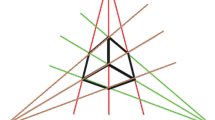Abstract
In this article a new method for the calibration of a vision system which consists of two (or more) cameras is presented. The proposed method, which uses simple properties of vanishing points, is divided into two steps. In the first step, the intrinsic parameters of each camera, that is, the focal length and the location of the intersection between the optical axis and the image plane, are recovered from a single image of a cube. In the second step, the extrinsic parameters of a pair of cameras, that is, the rotation matrix and the translation vector which describe the rigid motion between the coordinate systems fixed in the two cameras are estimated from an image stereo pair of a suitable planar pattern. Firstly, by matching the corresponding vanishing points in the two images the rotation matrix can be computed, then the translation vector is estimated by means of a simple triangulation. The robustness of the method against noise is discussed, and the conditions for optimal estimation of the rotation matrix are derived. Extensive experimentation shows that the precision that can be achieved with the proposed method is sufficient to efficiently perform machine vision tasks that require camera calibration, like depth from stereo and motion from image sequence.
Similar content being viewed by others
Explore related subjects
Discover the latest articles, news and stories from top researchers in related subjects.References
R.D. Arnold and T.O. Binford, “Geometric constraints in stereo vision,” Proc. SPIE, San Diego, 1980.
H.H. Baker and T.O. Binford, “Depth from edge-and intensitybased stereo,” Proc. 7th Intern. Joint Conf. Artif. Intell., Vancouver, pp. 631–636, 1981.
R.C. Bolles, H.H. Baker, and D.H. Marimont, “Epipolar-plane image analysis: An approach to determining structure from motion,” Intern. Comput. Vision 1:7–55, 1986.
O.D. Faugeras and G. Toscani, “Camera calibration for 3D computer vision,” Proc. Intern. Workshop Mach. Vision Mach. Intell., Tokyo, 1987.
O.D. Faugeras and G. Toscani, “The calibration problem for stereo,” Proc. IEEE Conf. Comput. Vision Pattern Recog., Miami, 1987.
R. Lenz and R. Y. Tsai, “Techniques for calibration of the scale factor and image center for high accuracy 3D machine vision metrology,” Proc. IEEE Intern. Conf. Robotics Automation, Raleigh, NC. 1987.
M.J. Magee and J.K. Aggarwal, “Determining vanishing points from perspective images,” Comput. Vision, Graph., Image Process., 26:256–267, 1984.
Y. Ohta and T. Kanade, “Stereo by intra-and inter-seanline search using dynamic programming,” Carnegie-Mellon University Tech. Rep. CMU-CS, 1983.
L. Pacioli, “De Divina Proportione”. Reprint of Codice Amhcosiana, Fontes Ambrosiani, 31, Milano, Italy, 1956.
Piero della Francesca De Prospectiva Pingendi, Edizione Critica, ed. Sansoni, Firenze, Italy, 1942.
A.N. Tikhonov and V.Y. Arsenin. Solutions of III-Posed Problems, Halsted Press, New York, 1977.
R.Y. Tsai, “A versatile camera calibration technique for high accuracy 3D machine vision metrology using off-the-shelf TV cameras and lenses,” IBM Res. Rpt. RC11413, 1985.
R. Y. Tsai and R. Lenz, “A new technique for fully autonomous and efficient 3D robotics hand/eye calibration,” Proc. 4th Intern. Symp. Robotics Res., Santa Cruz, 1987.
B. Odone, B. Caprile, F. Girosi, and V. Torre. “On the understanding of motion of rigid objects,” no. 5, Intelligent Robots and Computer Vision; Proc. SPIE 726, 1987.
G. Nagy and A. Falsafi, “Using vanishing points to locate objects with six degrees of freedom,” Pattern Recognition in Practice III, Amsterdam, May 1988.
B. Jiang, “Camera calibration technique using vanishing point concept,” IEEE CH 2503-1/87/000-0640, 1987.
Author information
Authors and Affiliations
Rights and permissions
About this article
Cite this article
Caprile, B., Torre, V. Using vanishing points for camera calibration. Int J Comput Vision 4, 127–139 (1990). https://doi.org/10.1007/BF00127813
Issue Date:
DOI: https://doi.org/10.1007/BF00127813




